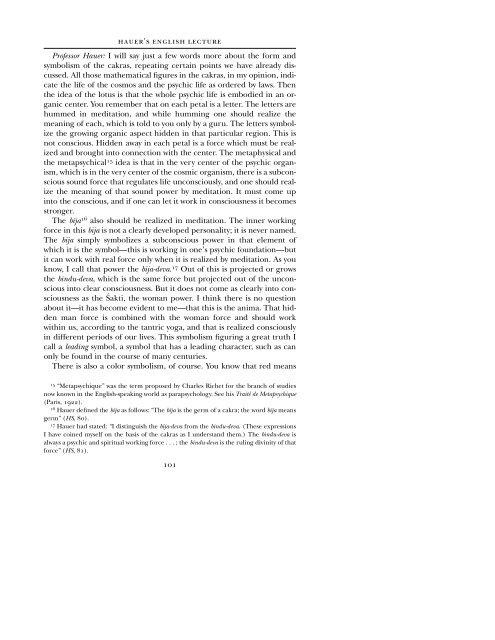CG JUNG - Countryside Anarchist
CG JUNG - Countryside Anarchist
CG JUNG - Countryside Anarchist
Create successful ePaper yourself
Turn your PDF publications into a flip-book with our unique Google optimized e-Paper software.
HAUER'S ENGLISH LECTURE<br />
Professor Hauer: I will say just a few words more about the form and<br />
symbolism of the cakras, repeating certain points we have already discussed.<br />
All those mathematical figures in the cakras, in my opinion, indicate<br />
the life of the cosmos and the psychic life as ordered by laws. Then<br />
the idea of the lotus is that the whole psychic life is embodied in an organic<br />
center. You remember that on each petal is a letter. The letters are<br />
hummed in meditation, and while humming one should realize the<br />
meaning of each, which is told to you only by a guru. The letters symbolize<br />
the growing organic aspect hidden in that particular region. This is<br />
not conscious. Hidden away in each petal is a force which must be realized<br />
and brought into connection with the center. The metaphysical and<br />
the metapsychical 15 idea is that in the very center of the psychic organism,<br />
which is in the very center of the cosmic organism, there is a subconscious<br />
sound force that regulates life unconsciously, and one should realize<br />
the meaning of that sound power by meditation. It must come up<br />
into the conscious, and if one can let it work in consciousness it becomes<br />
stronger.<br />
The bzja 16 also should be realized in meditation. The inner working<br />
force in this bzja is not a clearly developed personality; it is never named.<br />
The bzja simply symbolizes a subconscious power in that element of<br />
which it is the symbol—this is working in one’s psychic foundation—but<br />
it can work with real force only when it is realized by meditation. As you<br />
know, I call that power the bzja-deva. 17 Out of this is projected or grows<br />
the bindu-deva, which is the same force but projected out of the unconscious<br />
into clear consciousness. But it does not come as clearly into consciousness<br />
as the åakti, the woman power. I think there is no question<br />
about it—it has become evident to me—that this is the anima. That hidden<br />
man force is combined with the woman force and should work<br />
within us, according to the tantric yoga, and that is realized consciously<br />
in different periods of our lives. This symbolism figuring a great truth I<br />
call a leading symbol, a symbol that has a leading character, such as can<br />
only be found in the course of many centuries.<br />
There is also a color symbolism, of course. You know that red means<br />
15 “Metapsychique” was the term proposed by Charles Richet for the branch of studies<br />
now known in the English-speaking world as parapsychology. See his Traité de Metapsychique<br />
(Paris, 1922).<br />
16 Hauer defined the bzja as follows: “The bzja is the germ of a cakra; the word bzja means<br />
germ” (HS, 80).<br />
17 Hauer had stated: “I distinguish the bzja-deva from the bindu-deva. (These expressions<br />
I have coined myself on the basis of the cakras as I understand them.) The bindu-deva is<br />
always a psychic and spiritual working force . . . ; the bindu-deva is the ruling divinity of that<br />
force” (HS, 81).<br />
101


